Creating vs. Adapting Course Content
| Site: | Technology-Enabled Learning Lounge |
| Course: | Developing & Teaching Online Courses |
| Book: | Creating vs. Adapting Course Content |
| Printed by: | Guest user |
| Date: | Friday, 12 December 2025, 11:33 AM |
Description
This book guides you through the process of creating content pages in your course and what format aspects to take into consideration, such as balancing text and images, using images and captions, among other items. You will also consider adapting existing course content versus creating pages from scratch.
Creating vs Adapting Content
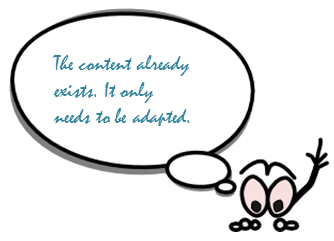 Famous last words! :-) There are three ways you can go about creating your course:
Famous last words! :-) There are three ways you can go about creating your course:
- You can write the content from scratch
- You can adapt existing materials to produce your course
- You can create a guide to an existing resource, such as a textbook, for example. This is typically called a "wrap-around" solution
Creating a Course from Scratch
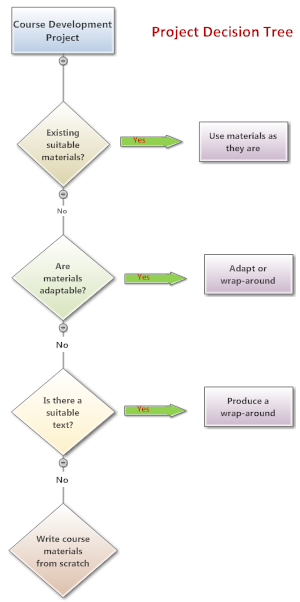
If there are no existing materials or resources in a particular subject-matter, at the depth and breadth you need or even in the language you need, you may consider writing your course content from scratch. Writing your own materials is a lengthy and costly process. From planning, to writing, reviewing, editing and piloting, you will be looking at a minimum of 6 months for a short course and up to a year for a bigger project. However, it gives you great flexibility in designing the content according to your own needs and context. Nowadays, with the growing access to quality OER, writing your own content, supplemented by external resources may be a good compromising solution that will offset the cost of writing content from scratch.
Adapting an Existing Course
Adapting existing content for your course may be a faster alternative and not as costly, depending on the suitability of the existing resources. However, it can turn into a more complex and time consuming task than anticipated and can derail online course development projects. Having said that, if content about a topic is already available it certainly is worth a careful analysis to determine the extent of the changes that will be required, if any. The increased availability of OER over the last decade has certainly made adapting of existing materials a more viable approach to course development. Rubrics such as the ones found on the Achieve site, are a very effective tool to help you determine suitability of the resources.
Creating a "Wrap-Around" Course
The "wrap-around" approach is one that can save you some time, provided that you have a quality resource to work with. If there is a good print manual for example, you may be able to get away with creating additional content, contextual examples and online activities to build on the print materials to develop your online course. This will definitely save you some time and will be a less costly approach.
Creating a Course from Scratch
When creating an online course from scratch, there are many elements that need to be taken into consideration to ensure a quality learning experience:
- The page layout
- The writing style
- How to use examples
- How to structure activities
- How to use bulleted lists and checklists
- How to use images
The next pages address each one of these in more detail.
Laying out Your Pages
When laying out your course pages it is important not only to guide learners through the content but also to engage them visually. Therefore, when deciding on the layout for your course's pages:
- Use titles and subtitles: Take advantage of the use of titles and subtitles to organise your content.
- Keep the lines of text short: it will make the blocks of text on the page easier to read. You can limit the length of the lines by using tables, or by creating a Cascading Style Sheer (CSS) that will apply the setting to all the pages you create. You may need a web programmer to assist with this.
- Use web friendly fonts that are widely available: this will ensure that the intended look and feel of your pages is maintained.
- Use "white space": as in print formats, "white space" is important when laying out a page. Make sure that there is enough space between blocks of text, between the titles and the subtitles and between the text and the images. "White space" on a page makes it more appealing and easier to read and locate information.
- Use colour: use colour to format text, titles and subtitles, but be careful not to abuse the use of colour. Pages with lots of different colours are distracting and can be hard on the eyes. If you have access to a graphics designer, ask for their assistance in designing the page layout for your course.
- Avoid long scrolling pages: it is difficult to find information in long scrolling pages. "Break" the content into smaller chunks so that you can create shorter pages that do not require endless scrolling.

Examples
The following are examples of two pages to give you an idea of what a good page layout may look like:
Writing Style
When writing course materials, allow your "teaching voice" to come through. This enables the learner to engage in what we call didactic discourse with the materials. This type of discourse fosters a sense of closeness between the learners and the "teacher" by simulating instructor presence. Learners feel that you are talking to them through the content you develop. In addition to maintaining a didactic discourse throughout, there are some other writing aspects that you should try to keep present as you develop online learning materials:
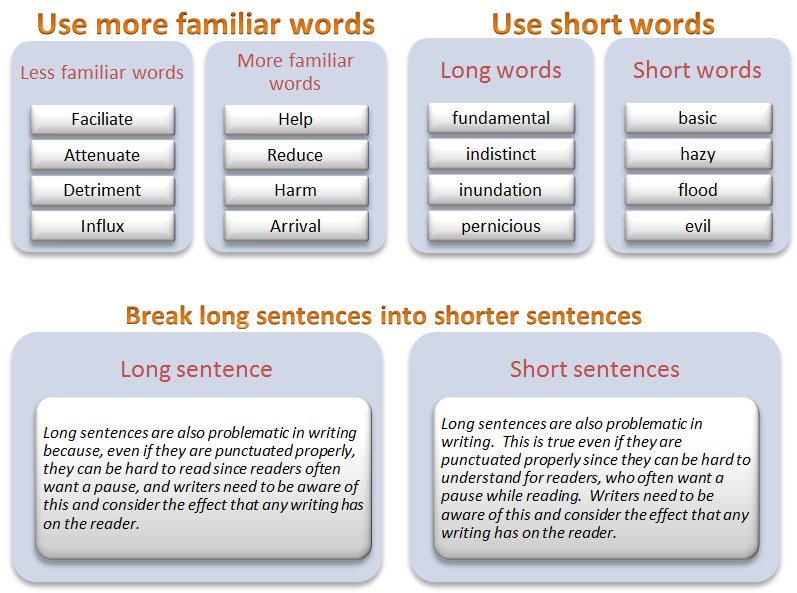
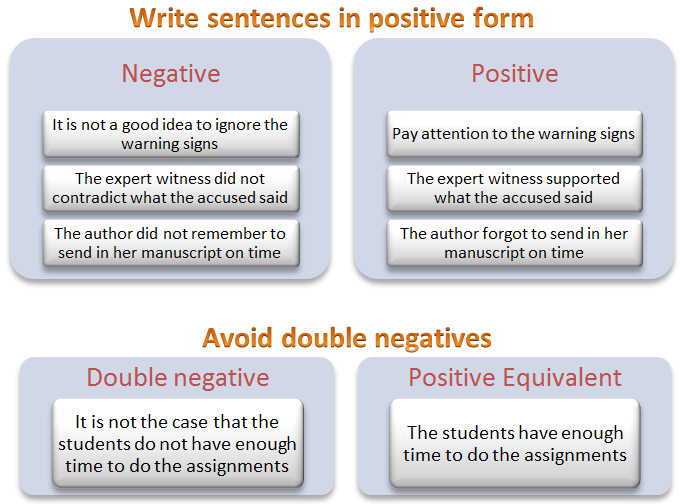
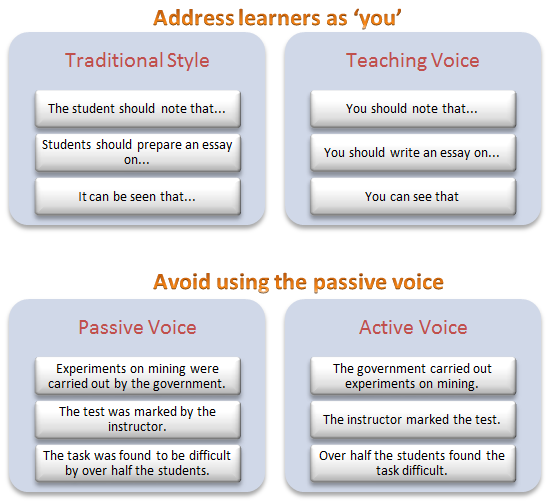
Using Examples
The use of examples in learning materials establishes relevance for learners, promotes experiential learning and fosters a more meaningful learning experience. Instructors tend to spend more time "telling" than "showing" and sometimes the "showing" can make all the difference.
Examples in online learning can take the form of descriptions of situations or concepts or places, photos of what you are teaching, a video of a process or a task. Video examples are ideal to show how to use machinery for example or how to replace parts in an engine.

Examples
If I am teaching accounting, for example, and I need to explain what an invoice is, I will wrap my explanation around showing a photo of an invoice and describing its components:
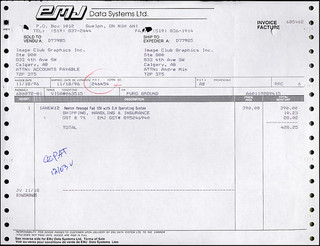
If I wanted to teach how to use a hammer, using a video such as the one below would probably be most effective and relevant for the learner:
Structuring Activities
Integrating activities for learners to do as they go through the content provides them with opportunities to practice what they have learned. Integrating activities in your course content is a good way to keep your learners engaged with the content and helps them with the cognitive processes (store and access information)
Activities in online courses can take many forms, from interactive objects (clicking on "hot spots" that lead to more information to dragging labels to the correct spots) to discussions or quizzes or webquests - your creativity is the limit. Active learning places learners at the centre of the learning process as they take responsibility for their own learning and is driven by activities such as discussions, case studies and problem solving.
Regardless of the type of activity you may have in mind for a specific chunk of content, what will make it successful is how you structure it: ensure that there are clear instructions for what learners are supposed to do, that the objective for the activity is stated and that it includes feedback to guide learners. Have a look at this activity format guide.

Examples
The following are examples of different types of activities. Notice how they are structured to ensure that learners know what to do and learn whether or not they are on the right track.
- Interactive learning about the ports of a computer
- COL's "Creating Learning Materials for Open and Distance Learning" includes a few samples of learning activities
Organising Content
Bulleted lists and numbered lists are a great strategy to organise your content and improve readability.
Bulleted Lists
Using bullets to present a list of items provides easy access to quickly skim through the items on the list, provided that the list is not too long. To make your lists effective, keep them to less than six items. More than that will be difficult to remember.

Example
Engaging online learning will include:
- Learning activities
- Examples
- Teaching voice
- Clear writing
- White space
Numbered Lists
Numbered lists are very useful to present hierarchical lists of items, when there is a sequential relationship between the items. It is a very effective strategy to list steps within processes. It is also good practice to keep them to less than six items.

Example
To drive a nail into a piece of wood:
- Prepare the nail, the hammer and the piece of wood
- Measure the thickness of the wood and the length of the nail (make sure the nail is shorter than the thickness of the piece of wood)
- Place the nail on the piece of wood
- Hit the head of the nail with the hammer until the head meets the wood
Check-lists
Check-lists are great tools to use in summaries at the end of a unit of learning and can be a self-check activity for learners, as you ask them to make sure they know all the concepts listed. They are also effective in guiding learners to monitor their progress throughout the course. You can create a checklist for each module and ask your learners to make sure they have completed all the tasks that were included in the module. Checking items off the list can be fun and relieving!
Using Images
 A picture is worth a thousand words... so goes the saying. But is the image we are using here contributing in any way to your learning about developing online courses? Not really, eh? So, just because a picture is worth a thousand words, it doesn't mean that we should use them indiscriminately in our courses. Like everything else that you have been learning in this course, it has to serve a purpose and be aligned with your learning objectives, your activities and your examples. Using images for decorative purposes only will become distracting and take up both storage space and precious space on your page. So think about it before you add "pictures" just because it will make the page look prettier.
A picture is worth a thousand words... so goes the saying. But is the image we are using here contributing in any way to your learning about developing online courses? Not really, eh? So, just because a picture is worth a thousand words, it doesn't mean that we should use them indiscriminately in our courses. Like everything else that you have been learning in this course, it has to serve a purpose and be aligned with your learning objectives, your activities and your examples. Using images for decorative purposes only will become distracting and take up both storage space and precious space on your page. So think about it before you add "pictures" just because it will make the page look prettier.
Tips for integrating images into your online courses:
- Use images to illustrate key aspects of the learning.
- Ensure images are relevant and within the context of the content you are teaching. Avoid using images for "decoration" only.
- Always include a legend to help learners interpret the illustration.
- Keep illustrations close to the relevant text on the page. Make sure the text close to the illustration helps learners interpret it and tell your learners why you are using it.
- Place illustrations only after you have made reference to them in the text. Don't refer to an illustration that you are not using.
- Whenever possible, use illustrations in activities and exercises.

Examples
This page in a WikiEducator tutorial about wikis demonstrates good use of images to support learning.
Adapting Content for Your Course
This table from COL's "Creating Learning Materials for Open and Distance Learning" guides you through the decision making process as you consider adapting vs creating your course materials. When you find resources that roughly meet your needs, then adapting those resources rather than creating the content from scratch may be a suitable decision. Depending on the quality of the resources, you may get away with re-using most of the content and adding a few activities and examples to ensure relevance to your learners' context. In most adaptation cases, you may have to re-design the assessment and self-assessment, and sometimes it is helpful if you re-do or add a summary and/or an introductory page, to bring your voice and perspective into the materials.
Steps in Adapting Materials
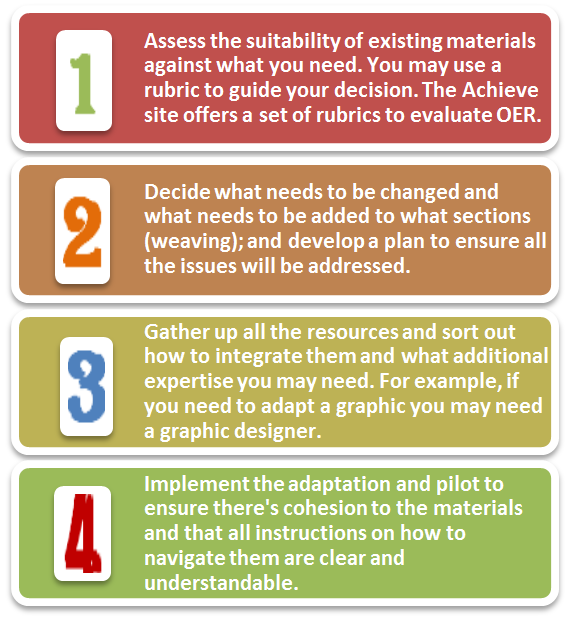
As you evaluate the resources to incorporate in your course, it helps to keep the following in mind:
- The target audience
- The learning content you need to teach
- The level of the resources in comparison to the level of what you need to teach
- The delivery language
- The delivery media
Assignment
By now you have considered creating content from scratch vs. adapting existing content and you have reflected on the writing style and the look and feel of your course pages... this means you are ready to Create Course Content in Moodle. Before you jump in make sure that you watch the Moodle video tutorials provided and learn a bit more about the LMS. It will save you some frustration if you are not very familiar with the learning environment.
After you watch the Moodle video tutorials, get started with the second book in this section. This book focuses on learner assessment and how to create quizzes and use the gradebook in the LMS.